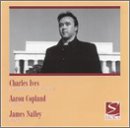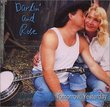| All Artists: Charles Ives, Aaron Copland, James Nalley Title: Charles Ives / Aaron Copland: Piano Works Members Wishing: 1 Total Copies: 0 Label: Eroica Classical Original Release Date: 7/9/2002 Re-Release Date: 9/7/2002 Genre: Classical Styles: Chamber Music, Historical Periods, Classical (c.1770-1830) Number of Discs: 1 SwapaCD Credits: 1 UPCs: 714548309722, 803680281222 |
Search - Charles Ives, Aaron Copland, James Nalley :: Charles Ives / Aaron Copland: Piano Works
 | Charles Ives, Aaron Copland, James Nalley Charles Ives / Aaron Copland: Piano Works Genre: Classical
Charles Ives, Sonata No. 1 Aaron Copland, Sonata JDT 3097 Charles Ives Sonata No. 1 (1902-1910) I. Adagio con moto IIa. First Verse: Allegro moderato IIb. Second Verse: 'In the Inn' Allegro III. Largo-allegro-largo IV.... more » |
Larger Image |
CD DetailsSynopsis
Album Description Charles Ives, Sonata No. 1 Aaron Copland, Sonata JDT 3097 Charles Ives Sonata No. 1 (1902-1910) I. Adagio con moto IIa. First Verse: Allegro moderato IIb. Second Verse: 'In the Inn' Allegro III. Largo-allegro-largo IV. Allegro-presto V. Andante maestoso Aaron Copland Sonata (1939-1941) I. Molto moderato II. Vivace III. Andante sostenuto James Nalley Piano Similar CDs
|
CD ReviewsBuy it, you'll love it... 10/10/2002 (5 out of 5 stars) "Hard to believe I've never heard of this guy. He's one of the best pianists I've ever come across. If you like American classical music, you won't be let down by this amazing performance." American Record Guide 01/08/2003 (5 out of 5 stars) "Copland: Piano Sonata Ives: Piano Sonata I James Nalley-Eroica 3097-65 minutesThe first impression of this release is the strong lyrical sense pianist Nalley brings to these thorny American works: the first sonata of Charles Ives with its atypical format of seven movements (two of which are grouped together), and Aaron Copland's only piano sonata with its three movements. Ives worked on this sonata on and off from about 1902 to 1929. Because of Nalley's sympathetic ear for Ives the experimenter, his sound is full of beauty, even in what may first strike the ear as startling dissonances. His lyrical and harmonic senses guide the ear through a thicket of otherwise confusing harmonies and textures. And the result is a revelation. While there are many passages full of clusters and unpredictable and irregular rhythms, expression and sound are enough to know what is going on, whether expansive and rhapsodic or foot-stomping dances. There are pockets of tonality, phrasing, and rhythmic gestures that keep the listener oriented. So for listeners who had just a few experiences with the more disorienting modern music of the last 50 years, or for those who skipped it but still went to movies in the meantime, this music will not seem so unmoored and forbidding as it was when first composed. Ives makes considerable musical and technical demands on the pianist. One can tell he had a good sense of the piano and what tends to work on the instrument, what is idiomatic and natural to the hands in this setting. Like Brahms, Ives was probably a big man whose physique seemed to influence the technical demands he made to convey his musical ideas. At first, there is a listener's satisfaction in recognizing and being able to name familiar melodies. But Ives's intention was to use familiar quotations, (such as 'Bringing in the Sheaves') that resonate with the American experience. Often this took the form of hymns from the Protestant tradition. The closer the listener's experience with this tradition, the deeper the resonance of the musical quotation. Copland's voice is unmistakable. Dating from 1939, his Piano Sonata, where I is so reminiscent of his Variations of 1930, is impressive with its many clangorous and granitic sounds--so many gestures made up of wide intervals and leaps. The playful and charming II resembles the helter-skelter scherzo of Samuel Barber's sonata. It uses the interval of a major 6th both melodically and harmonically as the main building block. III's tone is majestic and reverential. Nalley tunes in to the introverted expression, creating a timeless, other-worldly quality. The clangorous clusters resemble pealing bells, with their loud overtones. And as the movement fades out, the "bells" resonate as if at a distance. Remarkably played. This recording is a real treasure! BARELA" Excellent performance and superb sound! 09/19/2002 (5 out of 5 stars) "This is an excellent performance and the sound was superb!"
|

 Track Listings (9) - Disc #1
Track Listings (9) - Disc #1


